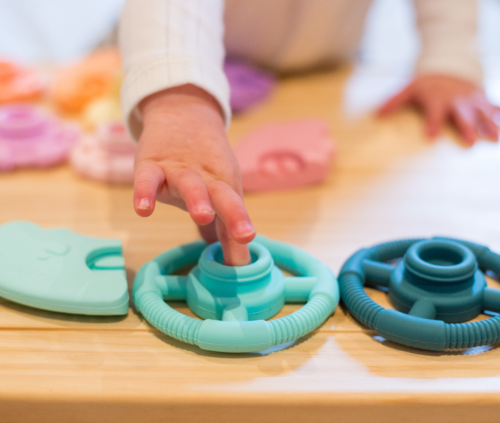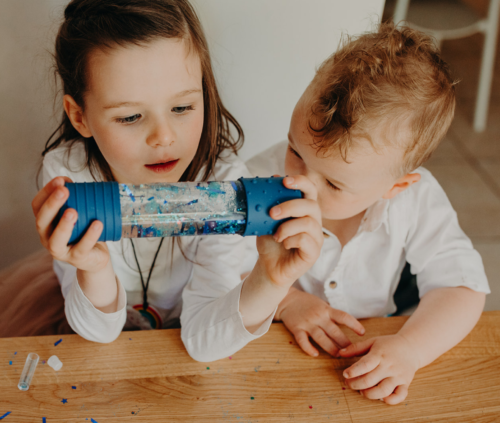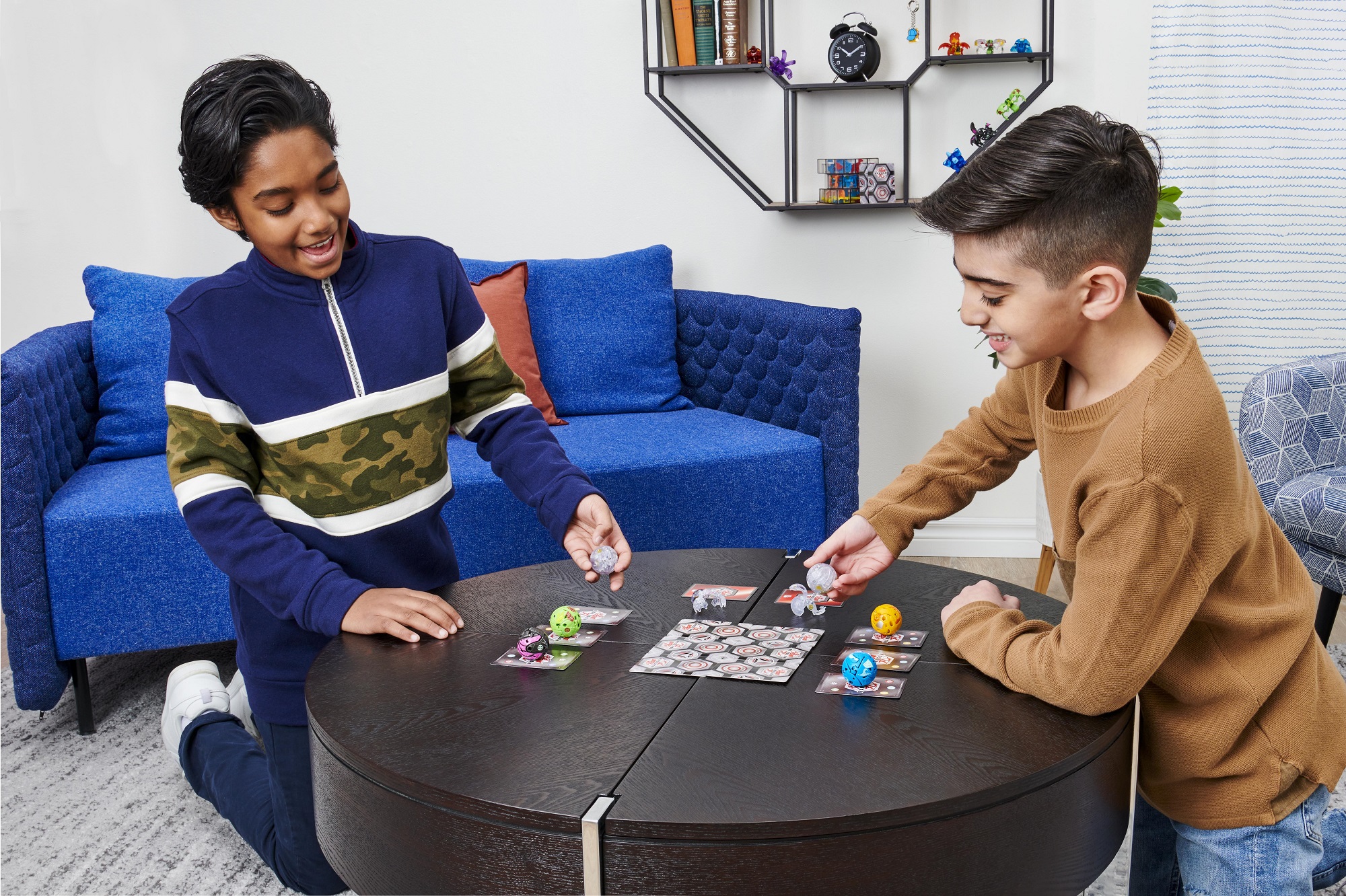Media kindly brought to you by Jellystone Designs
You’ve probably marvelled at babies’ and toddlers’ insatiable desire to touch, bite or otherwise interact with most things you put in front of them. It’s through these sensory explorations or ‘sensory play’ that they learn to perceive the world and gradually, their role within it.
At its simplest level, sensory play involves any activity by your child that stimulates the five core human senses: sight, smell, taste, touch, and hearing. Children crave sensory play, and they will seek it out whenever the opportunity strikes – such as squelching their hands through the food you’ve just prepared them! Truth be told, sensory play can sometimes get messy, but as you reach for the wipes, keep in mind that the sensory journey for babies and toddlers is signposted with some crucial learning milestones.
Our friends at Jellystone Designs are experts in facilitating children’s sensory play, with a trusted range of sensory toys and devices to facilitate babies and toddlers’ development, including teethers and chew pendants, sensory balls and stackers. Together, we canvass 10 amazing benefits of sensory play.

Early childhood brain development
Topping the list of sensory play’s amazing benefits is its impact on children’s overall brain development from the moment they are born. With their instinctual search for sensory input to perceive the world around them, the earliest signs of sensory exploration in babies can be seen when they turn their head towards sounds, use their eyes to follow moving objects, and find their hands and feet through the sensation of touch.
These senses operate independently to begin with, but by the time they reach 1 year of age, an exciting period of ‘sensory’ integration occurs where they can process information from different senses simultaneously – it’s when sensory play really comes alive! In fact, research shows that sensory play builds nerve connections in the brain’s pathways (source) and sets the foundation or memory for skills they will retain in later life. If you fancy your child to be a budding athlete or musician, take note! Let’s now look at the specific faculties of the brain that sensory play invokes.
Fine motor skills and hand-eye coordination
Compared to gross motor skills which involve coordination of major muscle movement such as walking and running, fine motor skills are focused on alignment of smaller muscle movements and more nuanced physicality such as learning to tie shoelaces, pulling a zipper up and down, or peeling off and attaching velcro. Sensory play taps into these fine motor skills and tends to combine with other sensory outcomes for added benefit, whether it’s using a paint brush to ‘colour inside the lines’, tapping the tiles on a xylophone, or threading pasta to make jewellery.

Language development
When exposed to different stimuli, it’s human nature to label and categorise based on known characteristics. Once toddlers have begun to develop their speech, they will search for ways to describe the textures, patterns, smells and temperatures they encounter, in order to make comparisons. Engaging in different types of sensory activities will give them more opportunities to identify whether something is sticky, hot, wet, slimy, soft – embedded in practical examples to ground their understanding. They’ll expand their vocabulary with such adjectives which will get increasingly more sophisticated as they grow older, and you might even have a future writer or storyteller on your hands!
Curiosity and an investigative mindset
You may have heard of the concept that “play is the work of the child”, which points to the legitimacy of play as the method by which kids learn and mature. A desire for play should be interpreted by parents as a thirst for knowledge in young children, and truly, the entry point for curiosity and problem-solving skills they will need in later life. For instance, if they’re plunging their fingers through a substance like dry sand only to find it ‘collapses’ when they try to roll it into a ball, and then make the realisation that wetting the sand allows them to make shapes, it’s this kind of trial-and-error learning that will turbocharge their logical thinking. Indeed, this ‘messier’ side of sensory play allows kids to test assumptions and observe cause and effect, which is precisely the kind of experimentation that forms the basis for scientific inquiry.

Sparks creative thinking
Similar to the experimentation that strengthens problem-solving skills, there is an unstructured element to sensory play that allows your child to develop and act on their imagination. Age-appropriate arts and crafts-based activities (think finger-painting and play-dough for the younger ones) are an excellent outlet for this creativity, involving pattern, texture and colour recognition to stimulate the senses. Of course, children will need a little parental guidance (and supervision) here, which is where a ‘sensory bin’ can be of enormous value for toddlers. Essentially a container filled with carefully selected materials to engage all the senses, it can get little ones thinking outside of the box, and you might find yourself nurturing a budding artist!
Settles the body and mind
Young children are not as adept as adults in processing and regulating sensory information, and this is demonstrated in an agitated toddler at a loud, busy shopping mall, or alternatively, an impatient and boisterous one in a quiet doctor’s waiting room. In both scenarios, reactions to sensory input are at work. It’s important to note that when kids underreact to sensory input, they may seek out more stimulation, whereas when kids overreact to it, they become overwhelmed and may seek to avoid the sensory input. You’re probably wondering, ‘what can I do in the moment to take off the edge, when my child is overloaded?’
A highly effective way to settle a child’s body and mind is through sensory play to trigger ‘proprioceptive input’. This is a fancy phrase to describe sensory information sent to our joints and muscles that make us acutely aware of our body’s position and related movements. Take for instance, ‘sensory bottles’, which are vessels filled with colourful, slow-moving objects such as glitter, for a visual display that mesmerises young children. Dubbed ‘calm down bottles’, they’ve been used by parents, teachers and therapists to help children self-regulate their breathing and improve their focus. For a customised and reusable calm down bottle your child is sure to love, check out the Jellystone website.
Concentration, focus and mindfulness
Appreciating the connection between sensory processing and your child’s attention span is the first step to productively engaging your young child. Disruptive, distracted or absent-minded behaviours can be masking an underlying need for sensory input, and there are plenty of immersive activities that can keep them focused. In fact, research has shown that children (and even adults) are more likely to stay motivated and committed to tasks that appeal to their senses ( Although you’ll want a variety, experiment to see which sensory input your child favours, such as music-making activities for children that feed off sounds, and fidget and chew toys for the more touch-based child.

Aids children on the spectrum
For children diagnosed on the autism spectrum, sensory processing issues are chronic. Their senses can be over- or under-sensitive, and they may require aids to increase their oral muscles during speech therapy. Oral-based sensory toys can deliver in both respects, bringing controlled relief to children on the spectrum as they navigate each new day.
Since children tend not to discriminate over objects that pose threats to their safety, we recommend introducing a safe, chewable device at the earliest opportunity. Even for children who aren’t on the spectrum, oral toys provide positive stimulation and help them self-regulate during periods of anxiety, plus support their attention-to-task. Jellystone Design’s popular range of fidget toys and chewable pendants have been created to suit this very purpose and are endorsed by leading occupational therapists.
Quote from a child Psychologist who uses Jellystone Designs’ pendants in her therapy:
“I love these. When I come across children and teens who chew their school uniform shirt collars, I always suggest silicone pendants! I suggest parents get these for their child because chewing can be a form of anxiety, sensory dysregulation (particularly for children/teens on the spectrum) and a way of managing overwhelm. So instead of chewing clothes, or headphone cords, chewing a silicone pendant is a way to channel this behaviour.”
Socialisation
Although sensory play can serve as a more solitary exercise, experiencing it with family members or other children offers learning through observation and promotes healthy social habits. Let’s face it; different types of stimulation can bring out the good, the bad and the ugly in children’s behaviour, but the more they are safely exposed to sensory experiences, the more familiar they will become in processing sensory input in a productive way that meets the expectations of family and peers. Stick with it, and it will plant the seeds for collaboration and cooperative play as they grow.
Sensory toys to facilitate play
Extending out the above-mentioned phrase, “if play is the work of the child, toys are the tools.” Provided you select age-appropriate toys and activities, it’s never too early to start the rewarding journey of sensory play for your child. Toys specifically designed for sensory enrichment are particularly useful in an indoor setting, and especially for babies and younger infants who are still a little too young to explore some of the stimuli in the outside world.
A collection of high-quality sensory toys will encourage children to use all their senses – exploring the surfaces with their fingers, bringing to their mouth, matching colours, etc.
In addition to their award-winning range of sensory input toys, Jellystone Designs’ new ‘Triblox’ are the perfect sensory tool. Comprising 9 coloured blocks numbered 1 – 9 with corresponding textured illustration on the other side, they are the perfect shape and weight for little hands to explore, line up, balance and stack, featuring tactile surfaces that can be squished and squeezed.
To explore the full range, visit Jellystone Designs.
To view on YouTube:









